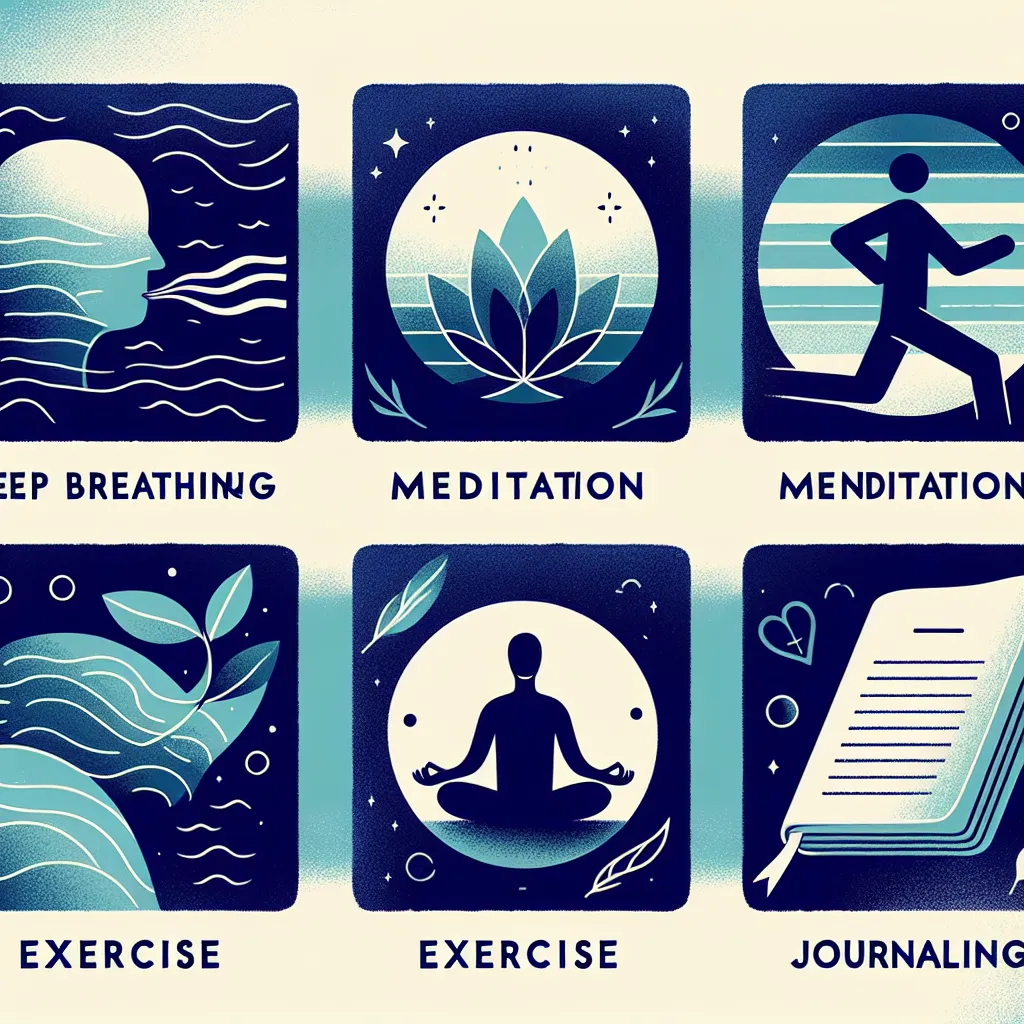The IELTS Reading section is a challenging component of the test, requiring candidates to demonstrate their English comprehension skills under time pressure. One common theme that has appeared in past IELTS Reading tests is “Tips for Reducing Anxiety.” This topic is not only relevant to test-takers but also reflects a growing interest in mental health and well-being globally. Based on the frequency of this theme in previous tests and its current relevance, there’s a strong possibility that similar passages may appear in future IELTS exams. Let’s explore a practice test on this subject to help you prepare effectively.
Nội dung bài viết
 Anxiety Reduction Techniques
Anxiety Reduction Techniques
Practice Test: Tips for Reducing Anxiety
Reading Passage
Anxiety is a common human experience that can significantly impact our daily lives. While some level of anxiety is normal and even beneficial in certain situations, excessive anxiety can be debilitating. Fortunately, there are numerous strategies that individuals can employ to manage and reduce anxiety effectively.
One of the most widely recommended techniques for anxiety reduction is deep breathing. This simple yet powerful method involves taking slow, deliberate breaths, focusing on inhaling deeply through the nose and exhaling slowly through the mouth. Deep breathing activates the body’s relaxation response, helping to calm the nervous system and reduce feelings of stress and anxiety.
Another effective approach is mindfulness meditation. This practice involves focusing one’s attention on the present moment, acknowledging thoughts and feelings without judgment. Regular mindfulness practice has been shown to reduce anxiety by helping individuals develop a more balanced perspective on their thoughts and emotions. Many people find guided mindfulness apps or recordings particularly helpful when starting their meditation journey.
Physical exercise is also a powerful tool for managing anxiety. Engaging in regular physical activity, whether it’s a brisk walk, a yoga session, or a more intense workout, can help reduce stress hormones and increase the production of endorphins, the body’s natural mood elevators. Moreover, exercise can serve as a healthy distraction from anxious thoughts and provide a sense of accomplishment.
Cognitive-behavioral therapy (CBT) is a widely recognized and evidence-based approach to treating anxiety. This form of therapy helps individuals identify and challenge negative thought patterns that contribute to anxiety. By learning to reframe these thoughts in a more realistic and positive way, people can significantly reduce their anxiety levels. While CBT is often conducted with a therapist, there are also self-help resources available that teach CBT techniques.
Maintaining a healthy lifestyle is crucial for managing anxiety. This includes getting adequate sleep, eating a balanced diet, and limiting caffeine and alcohol intake. Sleep deprivation can exacerbate anxiety symptoms, while a nutritious diet provides the body with the necessary nutrients to support mental health. Caffeine and alcohol, while often used as coping mechanisms, can actually increase anxiety in the long run.
Social support plays a vital role in anxiety management. Talking to trusted friends, family members, or joining support groups can provide emotional relief and practical advice. Sometimes, simply knowing that one is not alone in their struggles can be incredibly comforting.
Time management and organization can also help reduce anxiety, particularly for those who feel overwhelmed by daily responsibilities. Breaking large tasks into smaller, manageable steps and using tools like calendars and to-do lists can help create a sense of control and reduce stress.
Engaging in relaxing activities or hobbies can be an effective way to manage anxiety. This could include activities like reading, gardening, painting, or listening to music. These pursuits provide a positive focus and can help take one’s mind off anxious thoughts.
For some individuals, herbal remedies or supplements may offer relief from anxiety symptoms. However, it’s important to consult with a healthcare professional before trying any new supplements, as they can interact with medications and may not be suitable for everyone.
In cases of severe or persistent anxiety, professional help from a mental health expert may be necessary. Therapists and counselors can provide personalized strategies and support to help individuals manage their anxiety effectively.
By incorporating a combination of these strategies into daily life, many people find that they can significantly reduce their anxiety levels and improve their overall quality of life. It’s important to remember that what works best can vary from person to person, and it may take some time to find the most effective combination of techniques for each individual.
Questions
True/False/Not Given
- Deep breathing activates the body’s stress response.
- Mindfulness meditation involves focusing on past events.
- Regular exercise can increase the production of endorphins.
- Cognitive-behavioral therapy is only effective when conducted with a therapist.
- Caffeine consumption always reduces anxiety symptoms.
Multiple Choice
-
Which of the following is NOT mentioned as a benefit of exercise for anxiety reduction?
A) Reduction of stress hormones
B) Increased production of endorphins
C) Improved cardiovascular health
D) Distraction from anxious thoughts -
According to the passage, what is the role of social support in managing anxiety?
A) It provides financial assistance
B) It offers emotional relief and practical advice
C) It eliminates the need for professional help
D) It guarantees a cure for anxiety
Matching Headings
Match the following headings to the appropriate paragraphs in the passage. There are more headings than paragraphs, so you will not use all of them.
- Paragraph 4
- Paragraph 5
- Paragraph 7
Headings:
A) The Importance of Professional Treatment
B) Cognitive Approaches to Anxiety Management
C) Lifestyle Factors in Anxiety Reduction
D) The Role of Medication in Treating Anxiety
E) Building a Support Network
F) Time Management Strategies
Sentence Completion
Complete the following sentences using NO MORE THAN THREE WORDS from the passage.
- Deep breathing involves inhaling through the nose and ____ through the mouth.
- CBT helps individuals identify and challenge ____ that contribute to anxiety.
- Engaging in relaxing activities or hobbies can provide a ____ and help take one’s mind off anxious thoughts.
Answer Key
- False
- False
- True
- False
- False
- C
- B
- B
- C
- E
- exhaling slowly
- negative thought patterns
- positive focus
Explanations
- The passage states that deep breathing “activates the body’s relaxation response,” not the stress response.
- Mindfulness meditation involves focusing on the present moment, not past events.
- The passage explicitly states that exercise can “increase the production of endorphins.”
- The text mentions that while CBT is often conducted with a therapist, “there are also self-help resources available that teach CBT techniques.”
- The passage states that caffeine can “actually increase anxiety in the long run.”
- Improved cardiovascular health is not mentioned as a benefit of exercise for anxiety reduction in the passage.
- The passage states that social support “can provide emotional relief and practical advice.”
- Paragraph 4 discusses Cognitive-behavioral therapy, which matches heading B.
- Paragraph 5 talks about maintaining a healthy lifestyle, which matches heading C.
- Paragraph 7 discusses the importance of social support, which matches heading E.
- The passage states “exhaling slowly through the mouth.”
- The text mentions that CBT helps identify and challenge “negative thought patterns.”
- The passage states that engaging in hobbies can “provide a positive focus.”
Common Mistakes
When tackling reading passages like this one, test-takers often make the following mistakes:
- Overlooking key words: Pay attention to words like “not,” “always,” or “sometimes” that can change the meaning of a statement.
- Relying on prior knowledge: Base your answers solely on the information provided in the passage, not on what you already know about the topic.
- Misinterpreting True/False/Not Given questions: Remember, “Not Given” means the information is neither confirmed nor denied in the passage.
- Rushing through the passage: Take time to understand the main ideas and structure of the text before attempting the questions.
- Ignoring context: Consider the surrounding sentences when answering questions about specific details.
Vocabulary
Here are some challenging words from the passage along with their definitions:
- Debilitating (adjective) /dɪˈbɪlɪteɪtɪŋ/ – making someone very weak and infirm
- Exacerbate (verb) /ɪɡˈzæsəbeɪt/ – to make a problem or bad situation worse
- Deliberate (adjective) /dɪˈlɪbərət/ – done consciously and intentionally
- Endorphins (noun) /enˈdɔːfɪnz/ – hormones that reduce pain and increase feelings of well-being
Grammar Structures
Pay attention to these grammar structures used in the passage:
- Present Perfect: “Regular mindfulness practice has been shown to reduce anxiety” – Used to describe an action that started in the past and continues to have relevance in the present.
- Conditional sentences: “By learning to reframe these thoughts…, people can significantly reduce their anxiety levels” – Expresses a cause-and-effect relationship.
Tips for High Scores in IELTS Reading
- Practice time management: Allocate your time wisely between reading the passage and answering questions.
- Improve your vocabulary: Regularly learn new words and their contextual usage.
- Develop skimming and scanning techniques: These skills help you quickly locate specific information in the text.
- Read actively: Engage with the text by underlining key points and making mental summaries.
- Practice with various question types: Familiarize yourself with all possible IELTS Reading question formats.
- Focus on accuracy: It’s better to answer fewer questions correctly than to rush and make careless mistakes.
By following these strategies and practicing regularly with passages like the one above, you can improve your performance in the IELTS Reading section. Remember, reducing anxiety about the test itself is also crucial for success. Consider incorporating some of the anxiety reduction techniques mentioned in the passage into your own test preparation routine.
For more tips on managing test anxiety, check out our article on the best ways to reduce anxiety. You might also find our guide on how to manage anxiety and stress naturally helpful in your IELTS preparation journey.


